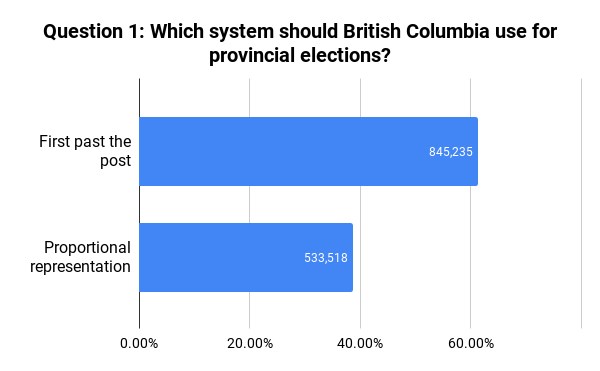Electoral reform failed because of confusion over the three forms of proportional representation and a perception that a change in the way we vote was self-serving for the NDP-Green coalition, says a political scientist.
“There is no existing party that would benefit more from a change to proportional representation than the B.C. Green Party,” said University of British Columbia political scientist Gerald Baier.
“So they couldn't help but be labelled as self-serving.”
However, Baier said he doesn’t think the endorsement of the current first-past-the-post system will destabilize the Green’s support for the minority NDP government.
Voters overwhelmingly endorsed the first-past-the-post system in the B.C. government’s electoral reform referendum, with 61.3 per cent in favour of the status quo and 38.7 per cent in support of proportional representation.
A total of 1.43 million people cast ballots cast, representing a 42.6 per cent turnout.

Andrew Weaver, leader of the B.C. Green Party, campaigned hard for proportional representation, as it likely would have helped the party pick up more seats. Weaver wanted the NDP to change the voting system through a simple vote in the legislature, but Premier John Horgan insisted on a referendum.
At a news conference Thursday, Weaver said for the Green Party, proportional representation was about fairness for voters, not a quest for power.
“We are not here playing House of Cards politics to try and get power,” Weaver said. “This has never been about power for the B.C. Greens, this is about democracy and representing the interests of the people of British Columbia.”
Weaver vehemently rejected the notion that the failure of proportional representation means B.C. Greens are a fringe party. “The B.C. Greens have not been, nor have they ever been, a fringe party.”
He said the fact that the party won 17 per cent of the popular vote in the last election shows that the B.C. Greens are one of the three main parties in B.C. He said his party influenced many government initiatives, including banning large political donations and climate change actions.
Both Weaver and Finance Minister Carole James said the referendum results do not weaken the “confidence and supply” agreement that props up the minority NDP government. Both said the two parties will continue to co-operate.
“We will remain an opposition party, we will continue to raise issues that need to be raised,” Weaver said.
Weaver and James agreed that electoral reform is off the table for the foreseeable future, adding that they will respect the will of the public.
While the provincewide vote rejected proportional representation, it received majority support to varying degrees in all Greater Victoria ridings except Saanich South. The ridings were among only 12 of the 87 in B.C. that supported a change.
Victoria-Beacon Hill, James’s riding, endorsed proportional representation by the biggest margin in B.C., 66 per cent to 34 per cent. Premier John Horgan’s riding of Langford-Juan de Fuca supported it, but by a thin margin — 51-49.
Bill Tieleman, co-founder of the No B.C. Prop Rep Society, said his group has said all along that proportional representation is “complicated and confusing.”
“We said that it was a risky idea for British Columbia,” he said. “And voters overwhelmingly agreed with us for the second time in nine years.”
Single transferable vote, a form of proportional representation, was turned down by B.C. voters in 2009. In 2005, 57 per cent of voters endorsed STV but that did not pass the 60 per cent threshold.
“I think this is the end of the line for proportional representation,” Tieleman said.
“I think those who genuinely want to improve our democracy need to look for other ways to do so other than the electoral system.”
Maria Dobrinskaya of Vote PR B.C., which campaigned for change, said she was disappointed “but it was a very clear outcome and the majority of British Columbians chose what they’re familiar with and we respect the will of the electorate.”
She said there was a “significant generational divide,” with young people the biggest supporters of proportional representation. Most polling showed about 70 per cent support for proportional representation in the under-35 age group, Dobrinskaya said.
Horgan said in a statement: “British Columbians have now spoken and chosen to stick with the current voting system. This referendum was held because we believe that this decision needed to be up to people, not politicians. While many people, myself included, are disappointed in the outcome, we respect people’s decision.”
In a statement, B.C. Liberal Leader Andrew Wilkinson said: “… millions of British Columbians sent a clear message to the NDP and Greens that their self-serving referendum was not going to be tolerated.”
Wilkinson said the process was flawed from the beginning “as the NDP stacked the deck to satisfy the Green Party and remain in power. This was never been about improving our democracy, it was always about power and control. The rejection of proportional representation by the people of British Columbia demonstrates a clear desire to keep political power in the hands of voters.”
- - -
Voters were asked to rank three proportional representation voting systems:
Dual member proportional: This would see the province’s single-MLA electoral districts merged with a neighbouring district to create a two-member district. Parties nominate two candidates. One seat would by awarded to the candidate with the most votes in the electoral district and the second seat would be allocated based on proportional province-wide votes.
Mixed member proportional representation (MMPR): This system combines single-member electoral districts elected under first past the post with proportional seats allocated on a regional or provincial level. Voters would cast two votes. They first select the candidate they wish to become the riding’s MLA. In the second vote, they choose from a regional list of names presented by each party. This system is used in Germany, Scotland, Wales and New Zealand.
Rural-urban proportional representation: This combines the single transferable vote system in urban and semi-urban areas and mixed member proportional representation in urban areas. The STV system creates larger ridings with multiple MLAs who are elected based on a preferential ballot system. Single transferable vote, or STV, was turned down by B.C. voters in 2005 and 2009
— With files from The Canadian Press



